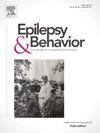Functional seizures: Scoping review of classifications and proposal of novel three-axis model
IF 2.3
3区 医学
Q2 BEHAVIORAL SCIENCES
引用次数: 0
Abstract
Functional seizures (FS), psychogenic non-epileptic, or dissociative seizures, are paroxysmal events characterized by sudden changes in movement, sensory perception, behaviour, or responsiveness. Over the last three decades, there have been proposals to classify FS semiology, but no definitive classification exists. An overview of available literature on classification schemes for FS is relevant and might serve as a starting point for developing a globally accepted classification of FS. In this scoping review, we aim to: 1. Identify available literature on proposed classifications of FS, 2. Clarify the concepts of the different classification schemes with their essential elements, 3. Discern commonalities between the different classifications. MEDLINE and Embase databases were systematically searched until 14–06-2023, using synonyms for FS, semiology, and classification, and articles describing FS semiology classifications were included. We included 38 studies out of 593 screened abstracts. We tried to map all classification terms on a two-dimensional plane of movement versus responsiveness. We found several classes to be consistently present: 1. Nonmotor, normal responsiveness; 2. Nonmotor, impaired responsiveness 3. Minor motor, variable responsiveness; 4. Hypermotor, impaired responsiveness. Some classification terms could not be mapped as additional core characteristics of the semiology on the two-dimensional plane due to timing and ictal evolution. Current FS semiology classifications partially are aligned along the motor and responsiveness axes. Our review synthesizes timing and evolution as additional class to fully characterize semiology of individual FS. We propose a novel three-dimensional model to describe individual FS semiology, including time on a third axis.
功能性癫痫:分类的范围回顾和新三轴模型的提出
功能性发作(FS),心因性非癫痫性或解离性发作,是一种以运动、感觉知觉、行为或反应性突然改变为特征的发作性事件。在过去的三十年中,有人提出对FS符号学进行分类,但没有明确的分类。对FS分类方案的现有文献进行概述是相关的,可以作为制定全球公认的FS分类的起点。在这次范围审查中,我们的目标是:1。找出现有的文献建议的分类FS, 2。2 .阐明不同分类方案的概念及其基本要素;辨别不同分类之间的共性。系统检索MEDLINE和Embase数据库,直到2023年6月14日,使用FS的同义词、符会学和分类,并纳入描述FS符会学分类的文章。我们纳入了593篇筛选摘要中的38篇研究。我们尝试将所有分类术语映射到一个二维平面上,即运动与响应。我们发现有几个类是一贯存在的:非运动,反应正常;2. 非运动性,反应性受损。小电机,可变响应;4. 运动过度,反应能力受损。由于时间和符号演化的原因,一些分类术语不能作为符号学的附加核心特征映射到二维平面上。目前的FS符号学分类部分沿着运动轴和反应轴排列。我们的综述综合了时间和进化作为额外的类别来充分表征个体FS的符号学。我们提出了一个新的三维模型来描述单个FS符号学,包括第三轴上的时间。
本文章由计算机程序翻译,如有差异,请以英文原文为准。
求助全文
约1分钟内获得全文
求助全文
来源期刊

Epilepsy & Behavior
医学-行为科学
CiteScore
5.40
自引率
15.40%
发文量
385
审稿时长
43 days
期刊介绍:
Epilepsy & Behavior is the fastest-growing international journal uniquely devoted to the rapid dissemination of the most current information available on the behavioral aspects of seizures and epilepsy.
Epilepsy & Behavior presents original peer-reviewed articles based on laboratory and clinical research. Topics are drawn from a variety of fields, including clinical neurology, neurosurgery, neuropsychiatry, neuropsychology, neurophysiology, neuropharmacology, and neuroimaging.
From September 2012 Epilepsy & Behavior stopped accepting Case Reports for publication in the journal. From this date authors who submit to Epilepsy & Behavior will be offered a transfer or asked to resubmit their Case Reports to its new sister journal, Epilepsy & Behavior Case Reports.
 求助内容:
求助内容: 应助结果提醒方式:
应助结果提醒方式:


